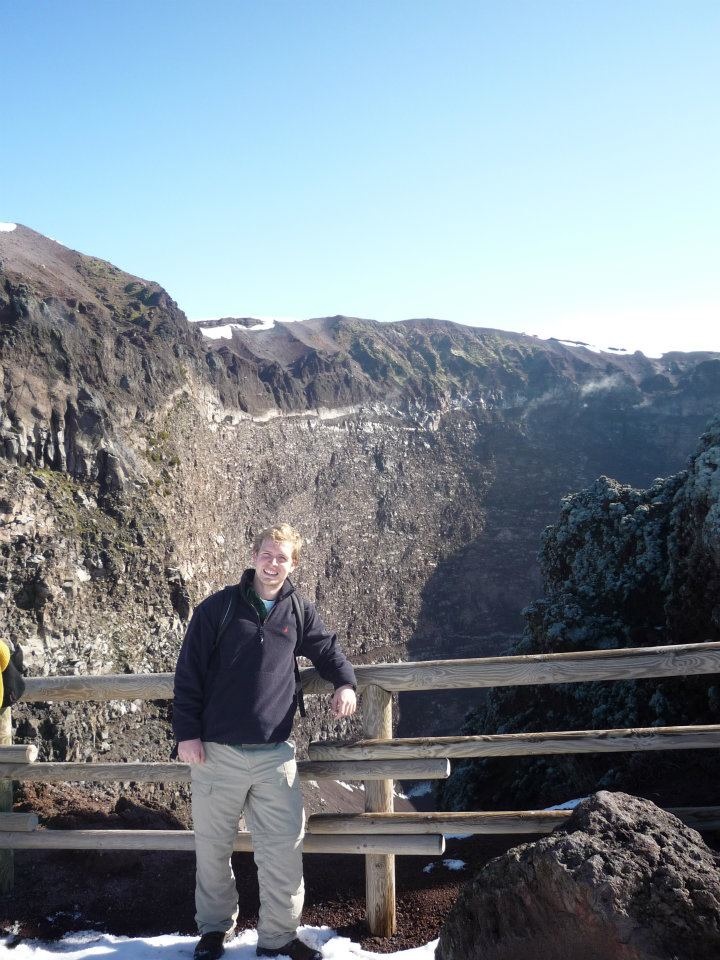 | Charles Kosman Employment after graduate work: Project Title:Diamonds of the Angolan Craton Project Description:A suite of alluvial diamonds from the Kasai River placers (Katanga area, the Democratic Republic of Congo) supplied by Angolan kimberlites provided the first insight into the deep diamondiferous mantle of this enigmatic craton. The project studied mineral and fluid inclusions in the diamonds to infer the thermal state of the cratonic mantle, the depth to the lithosphere-asthenosphere boundary and the parent diamond paragenesis. |
 | David Newton Employment after graduate work: Project Description:The project investigates petrology, mineralogy and geochemistry of peridotite and pyroxenite xenoliths of the Muskox kimberlite (Northern Slave craton). |
 | Evan Smith Employment after graduate work: Project Description:The project developed a new bulk X-ray diffraction method to characterize daugther minerals crystallizing from fibrous diamond and put forth new models for diamond formation that explain the difference between octahedral and fibrous diamond growth, as well as the difference between octahedral diamond growth in the lithospheric and the sublithospheric mantle. |
 | Christine Miller Project Title: Mineral inclusions in Wawa conglomerate diamonds Project Description: The project studies inclusions in a suite of diamonds extracted from Archean conglomerates of Wawa (N. Ontario, S. Superior craton). Samples are donated by Dianor Resources. |
 | Yvette Beausoleil Project Title: Eclogite xenoliths of the Jericho and Muscox kimberlites Project Description: Jericho kimberlite contains eclogites with widely varying compositions. The project calculates equilibrium temperatures and pressures of Jericho and Muscox eclogite, compares them with the equilibrium conditions for Lac-de-Gras eclogite and explores how eclogites of various types are distributed beneath the N Slave craton. |
 | Loryn Bruce Employment after graduate work: Project Title: Diamonds of Archean conglomerate of Wawa Project Description:The study compares characteristics of Wawa diamonds found in Archean conglomerates with diamonds emplaced by orogenic lamprophyres in the same area. The diamonds are characterized using infrared spectroscopy, cathodoluminescence (CL) optical and SEM microscopy. Unusual cathodoluminescence of the diamonds is controlled by emission of light at ~ 520 nm and can be related to the common source of diamonds or to the late metamorphism. A study of cathodoluminescence of metamorphic diamonds from various massifs around the world will help to solve this problem. |
 | Andrea De Stefano Employment after graduate work: Project Description:The study compares characteristics of Jericho diamonds formed below the Slave craton and Wawa diamonds emplaced by orogenic lamprophyres. The morphology, growth and etching features of the diamonds are studied using optical microscopy. Infrared spectroscopy is used to evaluate concentrations of nitrogen and hydrogen impurity in diamond, as well as the aggregation state of nitrogen. Mineralogy of diamond inclusions is studied on extracted grains and directly within the polished diamond slab using an electron microprobe. Carbon and nitrogen isotopic analysis of the diamonds, combined with the study of mineral inclusions, will determine isotopic signatures and carbon sources for the different types of diamonds. |
 | Bram van Straaten PhD Student (2005-2010) Employment after graduate work: Project Title:Volcanology of the Victor Northwest kimberlite pipe Project Description:The Victor kimberlite is a recently discovered economically diamondiferous pipe in Northern Ontario (Attawapiskat province). The kimberlite can be subdivided into three parts, Victor Main, Victor Southwest and Victor Northwest. The target area for the PhD research is Victor Northwest, the least understood area of Victor in terms of kimberlite geology and diamond grade. Victor Northwest appears to comprise crater-facies kimberlite formed by numerous diverse evenets that include extrusive magmatic kimberlites that may consist of coherent and clastogenic lavas, types of kimberlite not documented elsewhere. The project includes detailed logging of selected drill holes, open pit face mapping, analytical work on bulk kimberlite samples and on constituent minerals, review of downhole geophysics and geotechnical data, and development of the kimberlite emplacement model. |
 | Goran Markovic MSc Student (2004-2007) Employment after graduate work: Project Title: Megacrysts of the Jericho kimberlite pipe. Project Description:This project examines a rare suite of megacrystalline pyroxenites that grade to intergrowths of megacrysts of ilmenite, garnet, clinopyroxene and olivine. The study includes petrographic and mineralogical examination of samples, calculation of their P-T conditions of formation and re-equilibration, and Sr-Nd dating. |
Husin Sitepu Research Associate (2004- 2005) Currently Researcher at the Argonne National Laboratory Project Title: Application of synchrotron-based techniques to diamond exploration Project Description:This project was a collaborative effort between the University of British Columbia, the Canadian Light Source (CLS) and the Saskatchewan Research Council. The project took first steps to develop quantitative analytical tools for in-situ identification of mineral inclusions in diamonds using micro-X-ray Fluorescence (XRF). The research was done on the PNC-CAT 20-ID beam line at the Advanced Photon Source (APS), Argonne National Laboratory. | |
 | Nathalie Lefebvre MSc Student (2001 - 2004) Employment after graduate work: Project Title: Volcaniclastic breccia and diamonds of Wawa, Ontario. Project Description: The project comprised a comprehensive petrological and volcanological study of diamondiferous breccias (Wawa, Ontario) donated by Band-Ore Resources Inc. Band-Ore Resources also partially funded the research. Unusual diamondiferous rocks are found in Wawa subprovince of the Southern Superior craton. They are dated at 2.67 Ga and comprise part of a subduction-related volcanic sequence of the Michipicoten greenstone belt. The Wawa metavolcanics represent the first confirmed occurrence of diamonds in calc-alkaline lamprophyric rocks and should be considered a potential target for diamond exploration in the future. |
 | Pat Hayman MSc Student (2001 - 2004) Employment after graduate work: Project Title: Characterization of diamonds from the Rio Soriso, Juina area, Brazil. Project Description: The project studies the morphology, colour, fluorescence, cathodoluminescence, nitrogen content and aggregation state, internal structure and mineral inclusions in 69 alluvial diamonds from the Rio Soriso (Juina, Brazil). The Rio Soriso diamond suite is subdivided into several subpopulations that originated in the upper and lower mantle of ultramafic and mafic compositions. Most diamonds (90%) belong to the ultramafic paragenesis equilibrated in the lower mantle. Analysed ferropericlase grains are enriched in Fe (Mg#=0.43-0.89) typical of Juina ferropericlase reported elsewhere. We ascribe high Fe content of ferropericlase to its origin in the lowermost mantle. The Juina kimberlites may be unique in sampling the material from depths below 2000 km that ascended in a plume formed at the core-mantle boundary. |
 | Trevor Mogg Master's Student (2002 - 2004) Employment after graduate work Project Title: Petrology of the De Beers Snap Lake kimberlite, NWT. Project Description:This project was funded by De Beers Canada. The study involved a detailed petrographic and geochemical analysis using SEM, Microprobe and XRF in order to quantitatively characterize the Snap Lake hypabyssal kimberlite (Northwest Territories). This kimberlite body is in the form a shallow dipping sheet that averages 2 to 3 meters in thickness and has a proven aerial extent of 2 km by 3 km., which varies from the more common archetypical South African kimberlite pipe model. The project included characterizing the mineralogy and textures of various underground grab samples and approximately 100 surface drill core samples, taken over 7 years of exploration. Compositions of all minerals and bulk compositions of the kimberlite were analyzed to determine if this deposit is one phase or multiple phases of hypabyssal kimberlite. |














